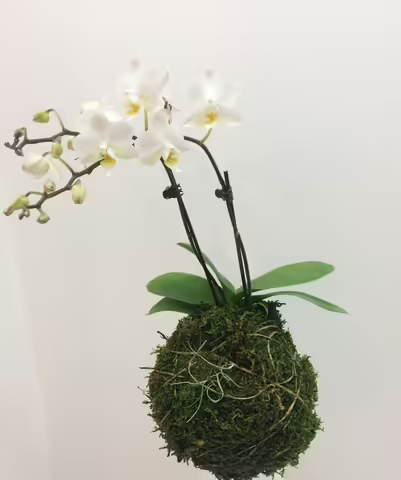URBANA, Ill. – Free your houseplants’ roots this winter by creating organic art for your home through kokedama, a form of Japanese bonsai, where plants are grown in a special soil mix and wrapped in moss. Kokedama is a uniquely beautiful way to grow houseplants in a non-traditional way.
Kokedamas can be displayed on decorative trays or dishes, antique bowls or saucers, or attached to a piece of driftwood. They can also be hung with decorative string or wire from a window or ceiling, creating a string garden with more than one. These beautiful, natural planters make a great gift or can add a little green to your winter space.
Many different kinds of plants can successfully be grown as kokedama says Brittnay Haag, University of Illinois Extension horticulture educator. An established houseplant that needs to be repotted, cuttings of houseplants with newly developed roots, or seasonal plants to decorate your space can all be planted in the moss balls.
"Ideal plants would be ones that can grow in drier conditions, such as ferns, philodendron, dracaena, spider plants, and even small orchids,” says Haag. “Succulents can also be planted in moss balls but will require less water.”
Kokedamas can be created with any size plant. The size of the ball will just vary to accommodate the root mass of the plant.
To create this simple, unique piece of living art, first gather the needed materials: a lightweight potting mix or peat moss, akadama, moss (sheet or Spanish), a plant, string, scissors, and water. Akadama is a coarse clay-like mineral used as bonsai tree soil.
Start by soaking the moss in a bucket of water for one hour to rehydrate the organic material. Then, squeeze out the excess liquid and set it aside. Combine the soil mixture of 70% potting mix or peat moss and 30% bonsai soil to create the ball. Slowly add water to the mixture until it can be pressed firmly into a ball without falling apart.
Remove the plant from its container and gently break apart the root ball and remove any excess soil and expose most of the roots. Create a hole in the soil ball large enough to fit the roots of the plant inside. You can also gently break the soil ball into two pieces, lay the roots on one side, and push the soil back together around the roots.
Press the moss around the soil ball until it is fully covered. Or, create a thin layer of moss on a flat surface, set the ball in the middle, and wrap the moss around the ball. Use the string to attach the moss to the ball. Secure the string to the ball and wrap it randomly around the ball in every direction to keep the moss in place. Tie it off tightly to create a firm, sturdy ball.
"Proper watering will be key to keeping your kokedama alive,” says Haag. “Stick your finger in the top of the ball near the base of the plant to feel if the soil is dry. The weight of the ball will also tell you. Is it light? It is time to water.”
To water the kokedama, fill a bucket or sink with lukewarm water. Gently push the moss ball into the water so it starts to absorb the water. Soak the completely submerged ball in the water for 15 to 20 minutes. Drain the water and squeeze the moss ball to remove excess water, and let it drip dry before returning it to its decorative space. Mist the moss ball between watering to keep it from completely drying out.
SOURCE: Brittnay Haag, Horticulture Educator, University of Illinois Extension
ABOUT EXTENSION: Illinois Extension, the public outreach and engagement arm of the University of Illinois, translates research-based knowledge into actionable insights and strategies that enable Illinois businesses, families, and community leaders to solve problems, adapt to changes and opportunities, make informed decisions, and carry technical advancements forward into practice.
PHOTO ACCESS: The photo in this article is available to download for media use.
